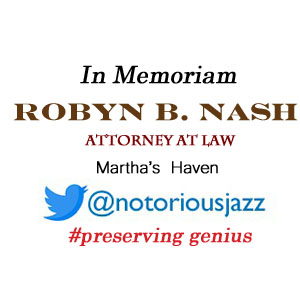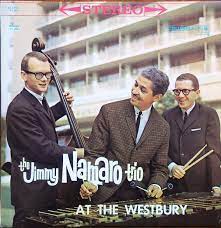
Daily Dose Of Jazz…
Jimmy Namaro was born James Namaro on April 14, 1913 in La Rosita, Mexico however, his family moved to Hamilton, Ontario in 1921. This is where he studied piano with Sid Walling and Eric Lewis.
He made his radio debut as a marimba player on CHML, Hamilton, and was heard in his teens on CFRB, Toronto, and on the CBC. In 1933, he was assistant conductor of a marimba band at the Chicago World’s Fair. Namaro subsequently pursued dual careers as the leader of pop or light jazz trios and quartets in nightclubs in Toronto, Canada and New York and as a popular CBC radio performer.
As a member of the Happy Gang from 1943 to 1959, he was also bandleader or soloist on several other CBC radio and television programs before moving to the United States in the Seventies. He was music director for Frankie Laine 1978-1993, with whom he toured the USA, Canada, and the UK. Namaro moved to Richmond, British Columbia, in 1987, where he continued to compose and to work with Laine.
His discography includes LPs Between 1958 and 1972 he recorded for Sparton, RCA Victor, Quality, Camden and others originally produced by the Canadian Talent Library Trust (CTL). Namaro wrote many jingles and composed music for CBC dramas such as the TV series Seaway, for the Broadway production Andorra, and for ballet. His paintings, in the primitive style, have had several exhibitions.
Vibraphonist, marimbist, percussionist, composer, painter Jimmy Namaro, who was naturalized Canadian around 1945, transitioned in Richmond, British Columbia on April 25, 1998.
More Posts: bandleader,composer,history,instrumental,jazz,marimba,music,percussion,vibarphone
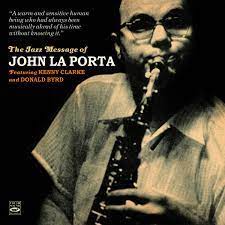
Daily Dose Of Jazz…
John Daniel LaPorta was born on April 13, 1920 in Philadelphia, Pennsylvania and started playing clarinet at the age of nine. He studied at the Mastbaum School in Philadelphia, alongside classmate Buddy DeFranco. As a teenager he played in local bands with Charlie Ventura and Bill Harris, and studied classically with Joseph Gigliotti of the Philadelphia Orchestra and Leon Russianoff at the Manhattan School of Music.
1942 saw him as a member of the Bob Chester big band for two years, then spent the following two years with the Woody Herman Orchestra. Beginning in 1947, he studied with Lennie Tristano, and with Teo Macero and Charles Mingus he was a member of the Jazz Composers Workshop, trying to combine jazz with classical music. Classically, he worked with Boston Pops, Leonard Bernstein, Leopold Stokowski, and Igor Stravinsky. In jazz he worked with Kenny Clarke, Miles Davis, Dizzy Gillespie, Charlie Parker, Buddy Rich, and Lester Young.
In 1956, La Porta played the first jazz concert in Venezuela at Caracas National Theater, where a selection of the repertoire performed was released under the title South American Brothers by Fantasy Records, becoming the first jazz recording in Venezuela.
As an educator he taught at Parkway Music School, then at public schools on Long Island, followed by the Manhattan School of Music and the Berklee College of Music. With guitarist Jack Petersen, he pioneered the use of Greek modes for teaching chord-scales.
In the 1990s, he retired to Sarasota, Florida, where he performed at the Sarasota Jazz Club and as a guest with the Fred Williams Trio. His autobiography is titled Playing It by Ear. Clarinetist and composer John LaPorta transitioned from complications of a stroke on May 12, 2004 in Sarasota.
More Posts: bandleader,clarinet,composer,history,instrumental,jazz,music

Daily Dose Of Jazz…
Jimmy Lewis was born April 11, 1918 in Nashville, Tennessee learned to play the bass and though little is known about his early years, he began working professionally with the Count Basie Orchestra and sextet in the 1950s. He went on to perform with Duke Ellington, Cootie Williams, Billie Holiday and Ivory Joe Hunter.
Moving to bass guitar during his time with King Curtis, Jimmy freelanced profusely, recording on over four dozen jazz, soul and R&B albums. He was a sideman and sessionplayer with Solomon Burke, Billy Butler, Al Casey, David Clayton-Thomas, Sam Cooke, Lou Donaldson, Byrdie Green, Grant Green, Tiny Grimes, John P. Hammond, Richard “Groove” Holmes, Alberta Hunter, Willis Jackson, Boogaloo Joe Jones, Charles Kynard, Johnny Lytle, Freddie McCoy, Galt MacDermot, Modern Jazz Quartet, Idris Muhammad, Mark Murphy, Houston Person, Sonny Phillips, Wilson Pickett, Otis Redding, Dave Pike, Arthur Prysock, Horace Silver, Johnny “Hammond” Smith, Buddy Terry, Charles Williams.
Continuing to perform and record up until the Eighties, double bassist Jimmy Lewis, who provided the basslines for the Broadway musical Hair, transitioned in New York City in 2000.
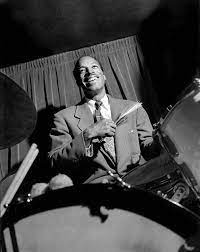
Three Wishes
The Baroness inquired of Jo Jones as to what his three wishes would be if granted and he responded with this simple statement:
-
-
“I have only one wish: to play ten more years.”
-
More Posts: baroness,history,instrumental,jazz,music,pannonica,three,wishes
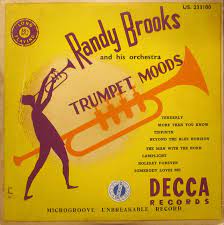
Daily Dose Of Jazz…
Randolph E. Brooks was born on March 28, 1917 in Sanford, Maine and began on trumpet at age six. By 11 he was discovered by Rudy Vallee and appeared on his Fleischman Hour radio show. He became a permanent member where he played thrilling trumpet solos, but was not allowed to play with the brass section of the band. By the time he was eighteen he was working with Jerry Blane for an entire summer in western New Jersey, followed by Gene Kardos and then Ruby Newman at the Rainbow Room in New York City.
Hired by Hal Kemp, he cut his first records for the Victor label in 1939. After Kemp’s death late in 1940, he stayed with the band when Art Jarrett took leadership. But by 1942 he moved on to a brief relationship with Claude Thornhill, followed by Bob Allen, but within a year he was playing with Les Brown before founding his own band in early 1945.
John Benson Brooks, who was not related, contributed arrangements to the ensemble that included Stan Getz in 1946. Among his hits for Decca Records were Tenderly, Harlem Nocturne, and The Man With The Horn, but unfortunately his swing-based style and large ensemble were out of step with the times, and his success eroded toward the end of the decade.
He married singer and bandleader Ina Ray Hutton and moved to Los Angeles, California where he suffered a stroke and was unable to continue as a musician. Trumpeter and bandleader Randy Brooks transitioned at the age of 49 of smoke inhalation in a fire at his Sanford, Maine apartment.on March 21, 1967.
More Posts: bandleader,history,instrumental,jazz,music,trumpet


